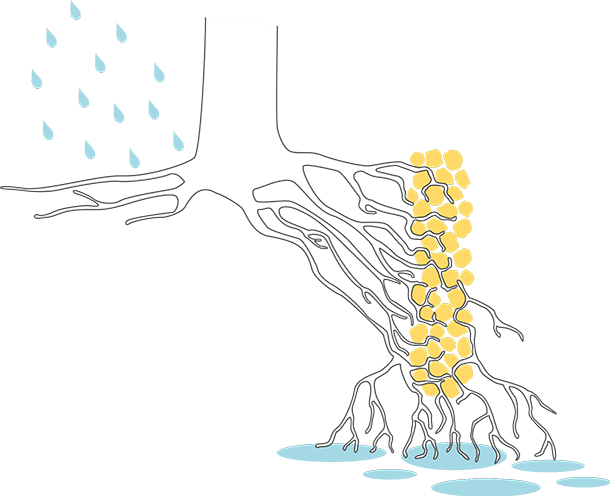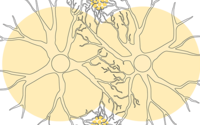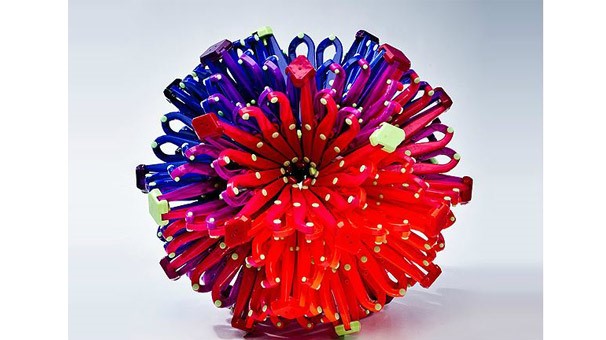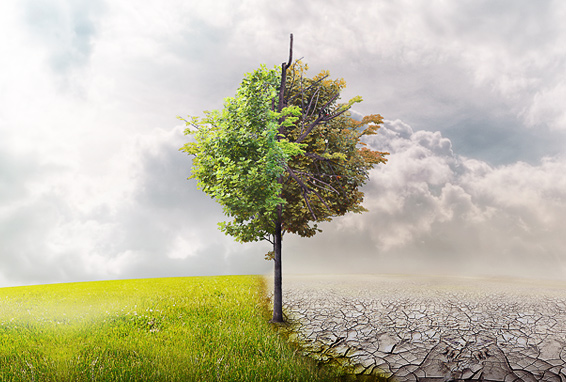- Climate, Environment & Health
TREES ON A DIVE

Trees not only aesthetically enhance the quality of life and the feel-good factor in urban areas, they also fulfill important functions for humans and animals. They help to improve air quality and prevent major heat accumulation in residential areas. They preserve biodiversity, provide habitats for numerous animal species, and offer nesting sites and food for wildlife. However, the hot and dry summers of recent years have taken their toll on trees in urban areas, as they increasingly suffer from drought stress.
Prof. Dr. Claus Mattheck, Dr. Klaus Bethge, Dr. Karlheinz Weber, and Dr. Iwiza Tesari from the Institute for Applied Materials (IAM) at KIT have published a method in the book "Klimafester Baum" (Climate-proof Tree) that comes to the aid of thirsty trees: a split cylinder for deeper root growth in more humid soil regions.
Found the problem
Already in 2019, many cities and municipalities have declared a climate emergency. The hot summer months have led to numerous tree deaths, and hundreds of trees have had to be cut down. To counteract further tree death, one city in North Rhine-Westphalia supplied its trees with around 270,000 cubic meters of water a day in 2020. This is not uncommon, as more and more major cities are laying pipes for underground irrigation in elaborate measures. Does this solve the problem? "Artificial irrigation close to the surface is not only cost-intensive, but inefficient in the long term. Although the trees are initially supplied with enough water to survive, their natural urge to root toward deeper water layers is thereby prevented," explains Dr. Karlheinz Weber, a research associate at the Institute for Applied Materials. This means that in the future, the trees will have to rely on constant watering during hot spells to avoid falling into drought stress. It's a vicious circle, because artificial irrigation solves the problem symptomatically, but doesn't eliminate the cause.

Solving the cause with split-cylinders
"We have to offer the roots an incentive to grow back down," says Prof. Dr. Claus Mattheck, now Distinguished Senior Fellow and former head of the Biomechanics Department of the Institute for Applied Materials at KIT. The split-cylinder technology developed by his team is much simpler, less expensive, and can be applied by anyone to a range of tree stands: from parks to urban avenues to hobby gardens. The process involves drilling holes about 20 to 30 centimeters in diameter and about one to two meters deep, depending on the soil type. The hole is drilled at a sufficient distance from the tree, filled with a mixture of grit and "terra preta" soil, and watered occasionally within the first
watered occasionally during the first two weeks. After that, the grit cylinders are expected to be self-sustaining and provide long-term access for water and fertilizer. Roots are attracted to the nutrient-rich and moist split cylinder, encouraging growth into the deeper, moister soil layers - not just under normal climatic conditions. When the top layer of soil dries out severely during prolonged periods of hot weather and water runs off mainly on the surface because it can no longer find a way into the lower layers, the split cylinder opens up the hard top layer, at least in places, and allows water to penetrate. "The roots grow towards the split cylinder and downwards in it. Once they have reached the lower end of the split cylinder and thus the moister layers of soil, the tree is armed against drought stress. Observations of nature have shown that a tree with only a single thumb-width root in wetter soil layers can survive a dry period alive because its water supply is guaranteed," Prof. Mattheck said.

“Trees are dying now“
Inspired by the root growth of trees in rock crevices, the researchers proved the split-cylinder theory in an early experiment with corn plants. "Since we wanted to show reliable results quickly, the corn plant proved to be predestined. A tree root grows a maximum of five millimeters in length per day. Our corn plants showed the same growth rate. After only a short time, it became clear that the corn plant in compressed urban soil grows only hesitantly through the hardened layers into the depths. With the split cylinder, on the other hand, the corn plant grew directly into the depths and showed several times faster growth," says Dr. Weber. Long-term tests on trees are currently underway at several locations in Germany. Although the practical test on the tree has not yet been completed, the research group has published its technology and the associated book. Time constraints have prompted them to take this step: "Trees are dying now. Everyone is talking about new species of trees that we can plant in the future. But we can't let the current trees all die; that would be an absolutely inefficient solution. Instead, we should think in the long term about how we can avoid the death of more tree species in the long term and thus also maintain the quality of life in our cities. The split cylinder is a first step towards this," says Prof. Mattheck.
Further links
Images: Institute for Applied Materials (IAM) / KIT








